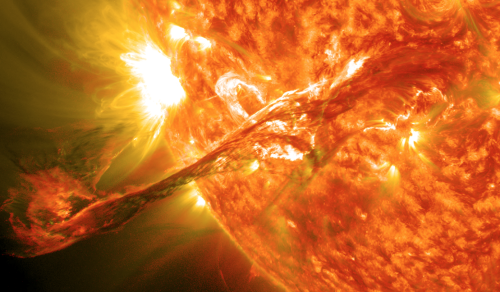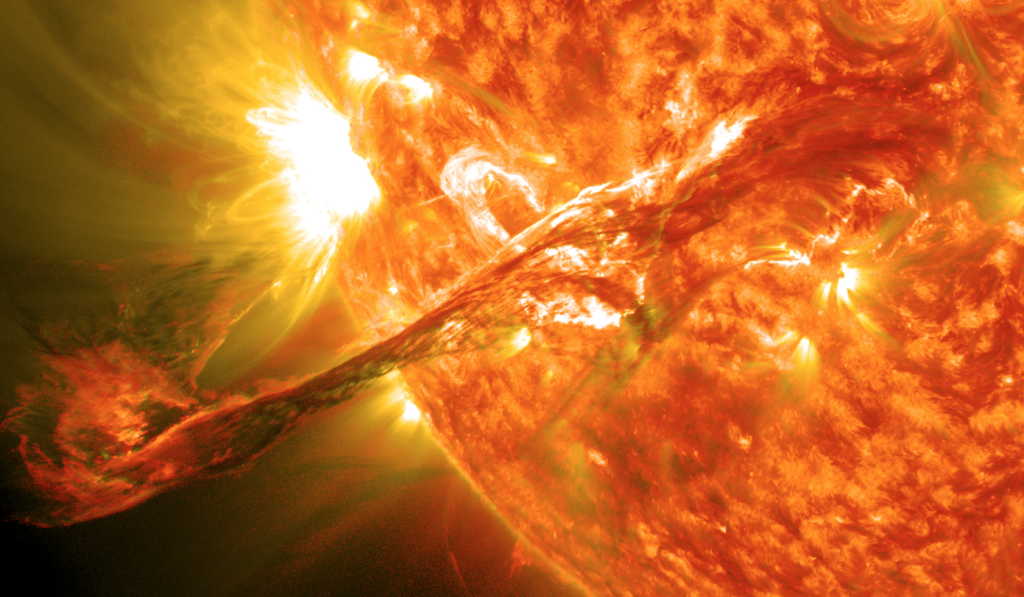
 Where were you on 23 July 2012?
Where were you on 23 July 2012?
It was likely just another day in a long hot summer in the northern hemisphere that has long faded in memory. The 2012 election campaign was shifting into high gear. President Obama was in Aurora, Colorado consoling families of victims of the largest mass shooting in U.S. history at a movie theater the Friday night before. Mitt Romney was at a fundraiser in San Francisco striking a somber tone. The entire nation was embroiled in a national debate on gun control. Japanese stock futures fell. Moody’s cut Germany’s economic outlook. The New York Yankees acquired outfielder Ichiro Suzuki from the Seattle Mariners. Syria claimed no chemical weapons were used against insurgents. Bond yields fell to record levels as stocks and the Euro slid amid rising debt.
Ninety-three million miles away a drama of a different sort was rapidly unfolding. A gargantuan explosion in the magnetic canopy of an emerging sunspot erupted close to the equator on the sun. Within ten minutes X-rays and ultraviolet light from one of the largest massive coronal mass ejections (CME) in recorded history tore through Earth’s orbit, effectively ionizing the upper layers of the atmosphere. Less than a hour later electrons and protons accelerated by the blast itself fried the electronics of scores of satellites, disabling GPS and telecommunications satellites. Earth’s magnetic field buckled, moaned and ‘broke’ under the onslaught of billions of tons of magnetized plasma, then reformed when it could, only to buckle again, repeatedly. The entire magnetosphere pulsated like a giant gong.
Almost anything plugged into a wall socket was damaged. Hundreds of giant transformers, the distributors of power across the vast electric grid, were turned into useless burned out heavy metal scrap within seconds as ground currents induced by massive solar storm melted the copper wiring at the center of the huge switches. Hundreds of millions of people found themselves suddenly without electricity and the prospect of being without power for weeks or even months. GPS, the Internet and the national electrical grid took a huge hit.
Water distribution was affected within hours. Perishable foods and medications were lost in the first day. Loss of heating/air conditioning, sewage disposal, phone service and re-supply wreaked havoc across the social infrastructure like a giant invisible tsunami. Banking, finance and transportation sectors were left reeling. Toilets all across the nation refused to flush because most urban water supply systems depend on electricity. Although gasoline and diesel could still be found, at least initially, in filling station storage tanks, the pumps were worthless without power. Even national security was threatened. Damage was estimated to be in the trillions, 20 times greater than the costs of Hurricane Katrina or, to put it in perspective, several TARPs.
Don’t remember?
Well, that’s because it didn’t happen quite that way. But it very well could have. In fact it almost did. The X-Class “super solar flare” and accompanying geomagnetic storm, perhaps the largest one on record, certainly the largest since the infamous Carrington Event of 1859, happened just the way I described. The powerful CME storm cloud blasted through Earth’s orbit that very day.
But fortunately the Earth wasn’t there.
It was, however, a very near miss. V-E-R-Y NEAR!
According to a seminal study published by University of Colorado’s Daniel Baker in the December 2013 issue of the journal Space Weather, had the eruption occurred only one week earlier, the Earth would have taken a direct hit.
Lucky for us, it hit the STEREO-A spacecraft instead, a solar observatory perfectly equipped to measure the massive eruption. It not only rode out the storm, it continued to record high quality data throughout the event. Because STEREO-A was in interplanetary space rather than within Earth’s magnetic field, it avoided dangerous electromagnetic currents and thus emerged unscathed after the onslaught.
Baker and other experts believe we would still be “picking up the pieces” had the Earth been in the line of fire. Multi-ton transformers taken out by the storm would likely have taken years to repair and replace.
The STEREO-A data set, after analysis, suggests the 2012 super storm was at least as strong as the great Carrington Event of 1859, named after the astronomer that described it. The only real difference was, it missed. We won’t always be so lucky.
Like Carrington, the super storm was an extreme event. Thanks to STEREO-A, we now know why. The super storm wasn’t just one CME ejected into space but several. The main event was actually two separate CMEs separated by 10-15 minutes according to Janet G. Luhmann, a space physicist at UC Berkley, and former post doc Ying D. Liu. They published their findings in the March 2014 edition of Nature Communications.
Even more interesting, the active region on the sun responsible for generating the July 2012 super storm produced several smaller precursor solar flares that essentially cleared the path taken four days later by the massive twin CMEs of 23 July.
The combination of smaller CMEs ‘plowing the road’ followed by much larger CMEs taking the same path appears to be one mechanism that separates extreme events from more ordinary large ones. Baker believes this “pre-conditioning” by multiple CMEs is important in the genesis of extreme events.
Physicist Pete Riley of Predictive Science, Inc. has gone one step further. He believes so-called extreme events may actually require an “ideal combination of a number of key features to produce the ‘perfect solar storm.’”
The super storm was an X-Class flare, the most intense category. Within each class there is a linear scale from 1 to 9 apart from the X-designation. An X2 flare is twice as powerful as an X1. The Carrington event is thought to have been well over X40! If, after analysis is complete, the super storm approaches that level, a new Z-Class designation may be assigned to extreme events, which, I predict, will immediately be termed the OMG-Class. Like an F5 Tornado, a Z-Class super storm will be considered the ‘Finger of God.’
How likely are extreme CME events?
Riley, in a paper entitled, “On the probability of occurrence of extreme space weather events,” published in the February 2014 edition of Space Weather analyzed over 50 years of solar storms. Extrapolating the frequency of ordinary storms to extreme ones, he calculated the odds of the Earth being hit by a Carrington-class storm…within the next ten years.
The answer? A sobering 12%
Even Riley was surprised. But, he states, the statistics appear to be correct. That suggests many people alive today will witness a direct hit from a solar super storm in their lifetime.
Going back to July 23, 2012, what would have happened had Earth been in the bull’s-eye?
The Northern Lights would have spread as far south as Cuba and Hawaii. After the storm began to fade, radio and GPS transmissions would have come back online fairly quickly.
Unfortunately, the same cannot be said of the electric grid. The problem is interconnectivity. Formerly local and regional grids are now mostly connected so the electrical power required, for example, in Los Angeles during peak summer days can come from as far away as Oregon and Washington. That all works great from an economic and efficiency perspective but is the exact opposite of what makes sense from a geomagnetic one.
The problem with so-called ‘optimized’ centralized complex technical systems is that they are highly tuned (i.e. specialized) to existing conditions. They are not very flexible or robust when conditions change rapidly. They tend to be brittle, non-fault tolerant and therefore easily susceptible to “cascading failure” scenarios when things go wrong. During a solar super storm, the architecture of our modern power generation and distribution system works against us, facilitating and even amplifying potential damage.
Decentralized power generation systems, the kind envisioned by alternative energy enthusiasts (think millions of electric cars powered by internal fuel cells running on hydrogen in which each car potentially its own mini-electrical power plant; or individual residential solar voltaic systems), are best in these kinds of circumstances.
A 132-page National Research Council Workshop Report released in 2008, four years before the solar super storm, entitled Severe Space Weather Events – Understanding Societal and Economic Impacts, detailed the anticipated terrestrial consequences of extreme solar storms. The NRC report estimated the minimal cost to the United States for a storm of this magnitude would exceed $2 trillion, more than the entire NASA budget for the next 113 years!
The implications for humans in Earth orbit, interplanetary space or on the surface of the Moon or Mars are significant and will be explored in future posts. A primer on space radiation can be downloaded at http://spaceenterpriseinstitute.org/2014/07/space-radiation-the-elephant-in-the-room-trumpets/
So, when will the next solar super storm erupt? No one knows for sure. It could be 100 years or 100 hours.
As Dr. Tony Phillips of Science@NASA has aptly observed, “Think about it the next time you flush.”


Wow. Very sobering indeed.
So, where can one go to find out what could be done (if anything) to prevent the worst of the consequences?
Good question Doug!
In this case prevention is the best approach. Since we can’t prevent solar super storms (we’re at the mercy of the physics on this one), our strategy should be a combination of (but not limited to) the following:
1. Basic and operational research on the terrestrial effects of solar super storms (e.g. improved computer models, destructive testing/design improvement on component hardware, etc.);
2. Improved space weather forecasting and rapid response (better and faster decision support systems for real time grid management in the early minutes of any event);
3. Upgrade and ‘harden’ the national grid to enable better real time monitoring of induced currents; immediate isolation of susceptible portions of grid to prevent negative feedback cascading scenarios;
4. Encourage proliferation of distributed (rather than centralized) power distribution systems and back-up emergency (this would facilitate homeland security/national defense goals as well by making the country less susceptible to acts of sabotage and terrorism);
5. Encourage local electricity production/consumption/distribution scenarios all the way to the residential level;
6. Establish requirements for longer-term backup power for hospitals, emergency communications, Internet (servers,etc.), police, first responders, etc.;
7. Production, storage and prepositioning of replacement large capacity electrical switches (i.e. transformers) in case of extreme event (this would significantly decrease the power outage time for the population).